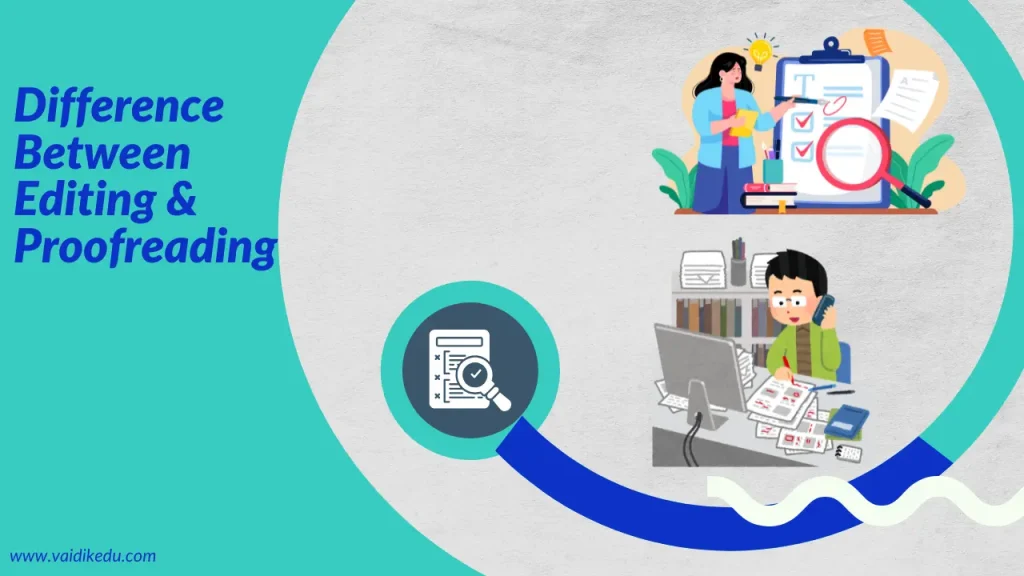There’s a fragile line of difference between good content and great content if the content details aren’t detailed. Even well-constructed content might have a negative impact if it consists of several errors in terms of its structure, grammatical errors, and many other elements.
The success rate of your writing depends a lot on the steps taken after the initial draft is completed. This is where the services of “Editing” and “Proofreading” can be put to use. The words are often used as synonyms.
However, both editing and proofreading are very different and serve very different purposes in the process of writing. Knowledge about these differences is very essential for a person who is looking forward to building his career in written communication to improve their work and ensure it meets the highest standard of quality.
What is Editing?
Editing is an extensive process that aims to improve the issues at the core of writing like improving the quality of content, structure of the sentences, and clarity of message. Editing helps in the smooth narration of the content by working on improving its clarity and readability.
Here is What Editing Typically Involves:
- Content Improvement:
The process of content improvement might come with suggestions of making an addition, improvement, or restructuring certain sections of the text, as the editor makes sure that the content written is properly structured, sounds logical, and meets the needs of the purpose for which it is designed.
- Structural Adjustments:
Editors keep an eye on the complete structure of the document, to make sure that the ideas written in the content are logically presented and have fluency in it. During this process, an editor might rearrange some sections, paragraphs, or sometimes an entire chapter to improve readability.
- Style and Language Enhancement:
Improving the style, tone, and language of the writing is one of the major focuses of an editor. The style and language are improved by making changes in vocabulary, paraphrasing the sentence, and ensuring consistency in the use of language.
- Concise and Clarity
Editors make sure to keep the text concise and clear by removing unnecessary and vague language that might confuse the reader in any way possible. An editor makes sure to use simple and understandable language.
- Checks Consistency:
Consistency in writing is ensured by editors in the form of formatting, the terminology used, and the style of writing. The editor makes sure that the content written follows the particular guidelines.
Example:
Suppose you have written a dissertation on the importance of warehousing facilities. Before the final submission, you have hired an editor to improve its overall quality. An editor will not only keep an eye on your grammatical mistakes but might also suggest you change the structure of your content, improve the overall fluency of the paper by making sure that one sentence relates to another, and make sure that the content is written logically and sequentially. The editor might even suggest you avoid the usage of technical words and stick to language that is easy to understand and might even ask you to add some additional data to make your content stronger.
What is Proofreading?
Proofreading can be considered as the surface-level check of your content and is mainly done over the final draft of your writing. It is mainly concerned with the errors that could distract the reader and doubt the level of professionalism of your document. Proofreading doesn’t involve an in-depth look over your content.
Key aspects of proofreading consist of:
- Grammatical and Spelling Check:
The proofreader looks for grammatical, spelling, or typo mistakes in the document that the editor might have overlooked.
- Syntax and Punctuation:
The proofreader keeps a check on syntax and punctuation errors. They ensure that the punctuations are used consistently and correctly. They also check for the presence of incorrect word order.
- Formatting Errors:
Verification of consistent formatting and is suitable to the guidelines is also ensured by a proofreader. This might include looking for the consistent use of fonts, alignment, and spacing.
- Consistent typography:
The proofreader keeps a thorough check on finding and correcting any typographical mistakes. Such as the mid-word capitalization, numerical formatting, etc.
Example:
Think about a business proposal that you made and is ready for submission. A proofreader will have a look at the proposal to make sure that the content written is free from any misspellings, or punctuation errors and that the type of formatting is used consistently.
Difference Between Editing and Proofreading:
Editing :-
Scope:- Broader in scope, as the overall quality of content is checked.
Stage in the writing process :- Is done just after the first draft is prepared.
Level of Detail:- Works on a major level to improve the quality of content.
Time Required :- Consumes a lot of time as it’s done to improve overall quality.
Proofreading :-
Scope:- Narrow in scope, a proofreader checks for grammatical and spelling mistakes.
Stage in the writing process :- Occurs after editing and is done on the final draft.
Level of Detail:- Works on minor details to ensure that content is free from errors.
Time Required :- Requires a short amount of time.
Conclusion
Editing and Proofreading are both very distinct services yet they complement each other during the writing process. Editing on the one hand is done to improve the quality of content, logical structure, and style of the document. On the other hand, proofreading is more related to making the document error-free. The usage of both is very important to ensure high-quality content and to increase the success rate during the final submission.
FAQS
1. Is it okay if skip editing and just proofread my content?
Skipping the process of editing might provide you with error-free content but it might lack the quality of clarity, logical structuring, and readability. Therefore, both services are very important for producing high-quality content.
2. What if I only require minor changes? What should I choose?
If the documents require only minor changes like correcting grammatical and typo errors, you can opt for proofreading. Editing is required when you have to improve your content in all aspects.
3. Is it okay if I hire the same person for both editing and proofreading services?
It’s beneficial to hire different people for both services to get a fresh perspective.
4. How can one know if the document needs editing or just proofreading?
If the document has been revised several times, and the person is confident about the quality and structure of his content, proofreading is all you need.










